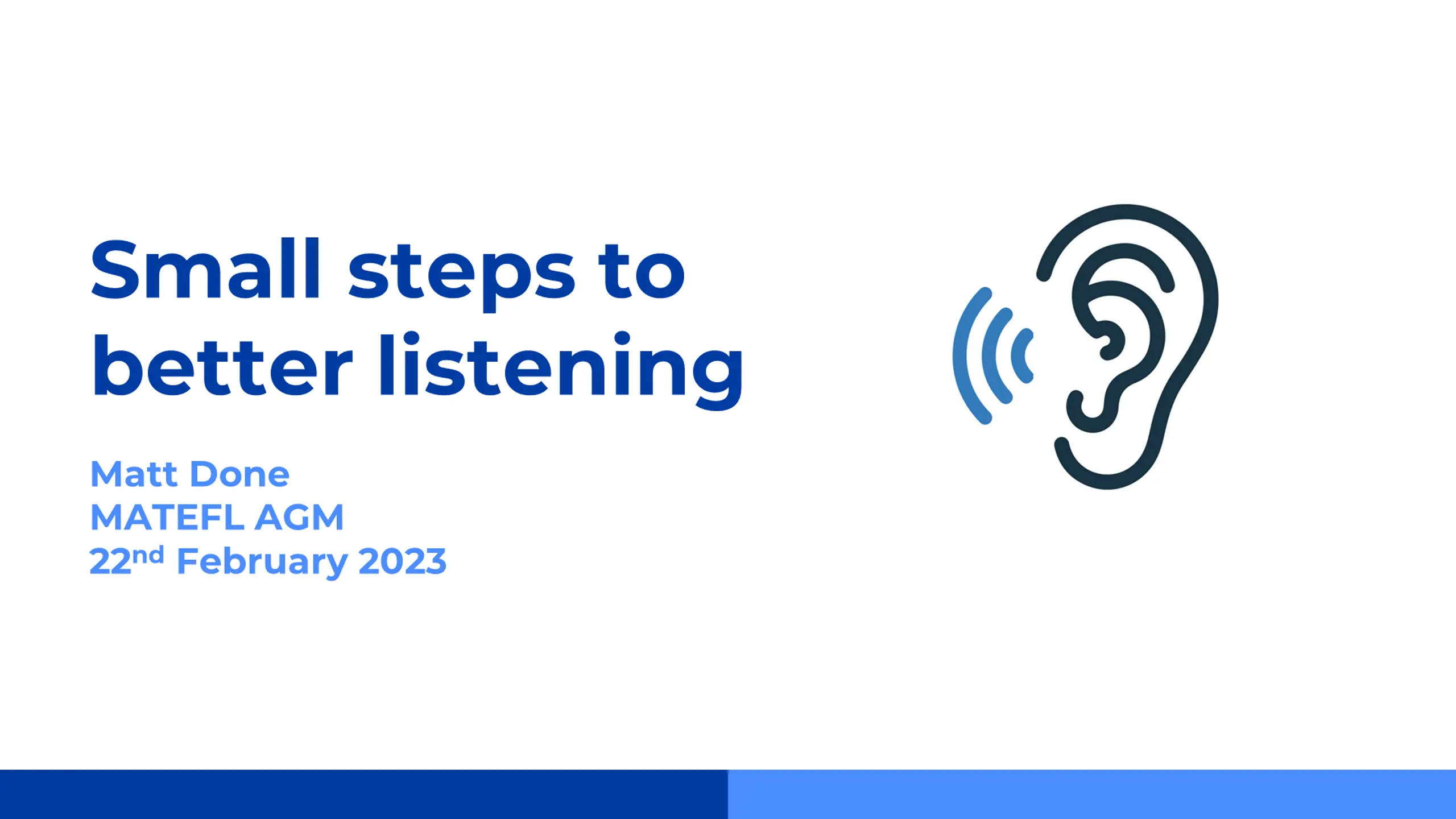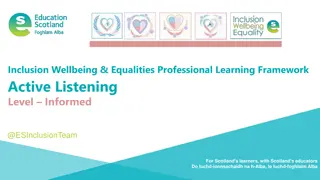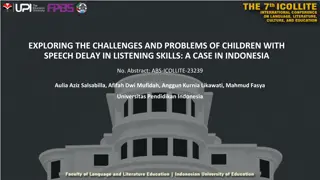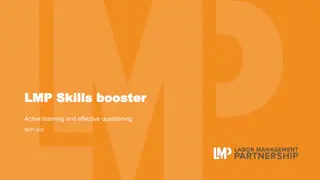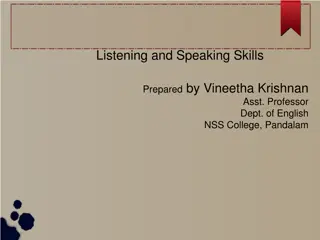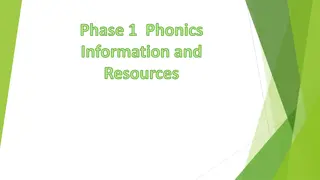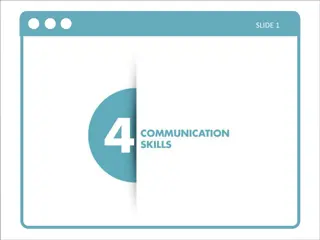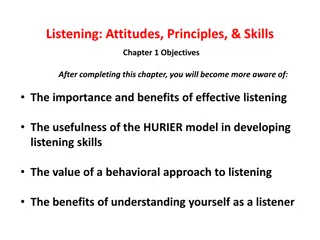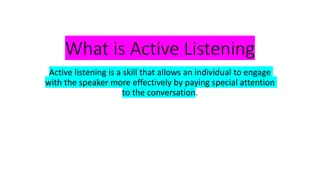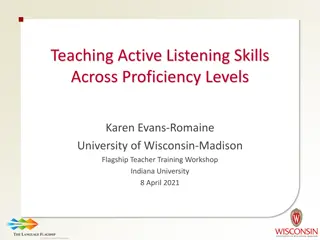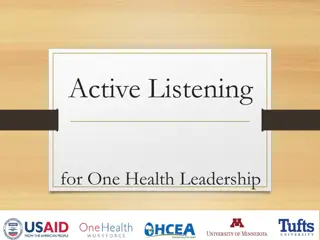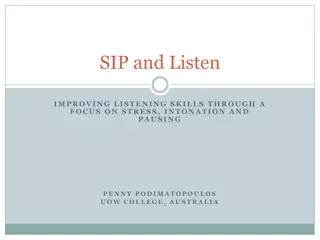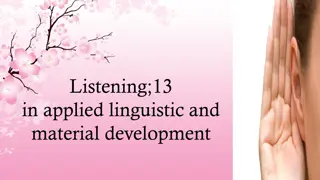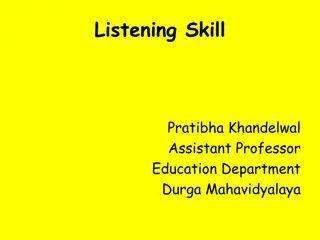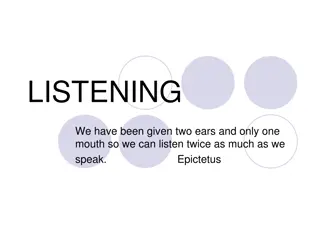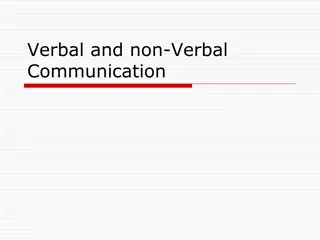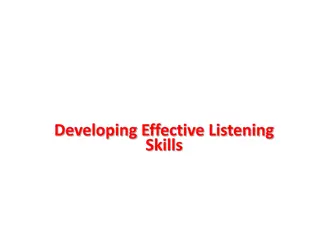Small steps to better listening
Enhance listening skills by differentiating between comprehension and language focus, using structured audio resources, and addressing real-world listening challenges. Explore strategies to improve language learning through clear pronunciation modeling and diverse linguistic contexts.
Download Presentation

Please find below an Image/Link to download the presentation.
The content on the website is provided AS IS for your information and personal use only. It may not be sold, licensed, or shared on other websites without obtaining consent from the author.If you encounter any issues during the download, it is possible that the publisher has removed the file from their server.
You are allowed to download the files provided on this website for personal or commercial use, subject to the condition that they are used lawfully. All files are the property of their respective owners.
The content on the website is provided AS IS for your information and personal use only. It may not be sold, licensed, or shared on other websites without obtaining consent from the author.
E N D
Presentation Transcript
Small steps to better listening Matt Done MATEFL AGM 22ndFebruary 2023
Teacher, I understand you very well but out there I don t understand anything! Have you ever heard similar comments from students? What would you say to a student if they said this to you?
The comprehension approach to listening Lead in First listening (gist questions, checking simple details, etc.) Second listening (comprehension questions, true or false, multiple choice, etc.) Language focus Lead out
Logical, structured The audio itself realistic? Exposure No false starts or hesitation Can be a source of new Often clear and slow language No background noise Speakers politely wait their turn Usually non-participatory Is essentially a test
Objectives Going beyond just testing learners listening Trying to help learners deal with real world listening challenges
1. Teach a lot of new language Listening problems or language problems? More language learners understand more spoken English (in theory) When teaching new language, give students an idea of what it might sound like
The greenhouse, the garden, and the jungle (Cauldwell, 2012) Modelling the pronunciation of new language 3 times each time slightly differently
The greenhouse Every word is pronounced clearly; there is no contact with other words I just did it out of curiosity
The garden Words come into gentle contact with other words I just did it out of curiosity
The jungle Words are squashed together, sounds are dropped, new sounds are created Ijusdidiouwa curiosity
Savour the difference I just did it out of curiosity Ijusdidiouwa curiosity
Greenhouse, garden, and jungle Can help learners see how sounds and words change when spoken quickly and naturally
Formulaic chunks I ve already I ve got to I should have Would you like There s a lot of Do you want to
Modelling language 3 times I ve already done it Would you like a drink? I should have asked him
Modelling language 3 times Vocal gymnastics Taking a botanical walk
Teaching individual words Individual words have a variety of possible sound shapes
Soundshapes = where But I wasn t really sure WHERE Depends WHERE you want to go WHERE the Christmas tree was
Yings dilemma I believe I need to learn what the word sounds like when it is used in the sentence. Because sometimes when a familiar word is used in a sentence, I couldn t catch it. Maybe it changes somewhere when it is used in a sentence (Goh 1997, p. 366).
Another resource https://yohasebe.com/tcse/
Summary of ideas 1. Teach new language and model its pronunciation x3 2. la 3. la 4. la 5. la 6. la
2. Integrate pronunciation into the lesson The police seem to know what s going on, but they just turn a blind eye to it. Which word(s) is/are likely to be stressed? Do any words join together ? Are any words weakened? Are any sounds dropped? Are any new sounds introduced between words?
A pronunciation/ connected speech focus is also useful for listening
The word blender (Hancock and McDonald, n.d) apple zum pears = apples and pears
Summary of ideas 1. Teach new language and model its pronunciation x3 2. Integrate pronunciation into the lesson 3. Bl 4. Ba 5. la 6. la
3. Let the listening be diagnostic too Your student gets an answer in the listening test wrong. What are some possible reasons for this?
Possible reasons 1. Speech too quick and/or unclear for the learner 2. Learner mistook a word for a similar sounding one (e.g., seminar / cinema) 3. Unknown vocabulary/language 4. Confusing wording in the question 5. Learner s interpretation was different to the official one 6. Something else (e.g., not paying attention, etc.)
Possible reasons 1. Speech too quick and/or unclear for the learner 2. Learner mistook a word for a similar sounding one (e.g., seminar / cinema) 3. Unknown vocabulary/language 4. Confusing wording in the question 5. Learner s interpretation was different to the official one 6. Something else (e.g., not paying attention, etc.)
Reflecting on listening (based on Field, 2009, p.93) Roughly how much of the listening did you understand: The first time you listened? ____% After listening a few times? ____% When listening with the audio script? ____%
Using the audio script, write down some words/phrases that you know that a) You didn t catch the first time you listened, but you caught after a few listenings b) You only caught when you had the audio script c) You found it hard to catch even with the audio script
Now look at these words/phrases and try to think about why you had problems recognising each one: a) The word/phrase wasn t said in a normal way b) The word/phrase wasn t easy to hear c) I confused it with another word/phrase d) Another reason
Using the audio script, write down some new words you heard. What did you do when you heard each one? a) I ignored it b) I tried to guess the meaning (how did you guess?) c) Something else
Using the audio script, write down any grammatical structures you didn t recognise. Why do you think you didn t recognise each one? a) I misunderstood/didn t hear important words b) I didn t catch the inflections (e.g., ed, -ing) c) I heard all the words but couldn t put them together d) The grammar was new for me e) Another reason
Do you think your listening has improved after this practice? If yes, how? a) Recognising words in speech b) Guessing meaning of new words c) Recognising grammar in speech d) Understanding meaning e) Other
Diagnostic listening Gives both teacher and learner an insight into listening issues Can enable us to target specific problems
Summary of ideas 1. Teach new language and model its pronunciation x3 2. Integrate pronunciation into the lesson 3. Let the listening be diagnostic 4. la 5. la 6. la
4. Do micro-dictations Write what you hear: Yeah, just give me a second I ve honestly never seen anything like it About half an hour What s he on about? Have you got any coins? I don t know to be honest
Formulaic chunks Suitable for micro-dictations Can be pulled out of a listening text and replayed after the main activity Can be focused on at the start/end of a lesson as revision Can be played on a device or read out Useful to focus on what happens when they re said quickly
A window into the listeners mind (McDonald, 2020)
What was said vs what was heard Gets on well Get some well A lot smaller than Lots more than I only needed I only need I want to go I won t go McDonald (2020)
Dictations as remedial work I want to go I won t go I want to know I won t know I won t eat I want to eat I won t sleep I want to sleep
Summary of ideas 1. Teach new language and model its pronunciation x3 2. Integrate pronunciation into the lesson 3. Let the listening be diagnostic 4. Do micro-dictations 5. la 6. la
5. Make listening more individual Listening usually done as a whole class However, learners work at different paces Learners will encounter different challenges when dealing with a listening text
Set listening homework (Field, 2009) 1. You will hear two people having a conversation while waiting for a bus. What do you think the relationship is between the two? What are they talking about? Check your answers.
2. Listen again. In what order are the following mentioned? The 13.30 bus to Reading The recent bus strike The 13.37 bus to Didcot The bus timetable displayed at the bus stop The information office Check your answers. Replay any parts where your answers are wrong.
3. Listen to these sentences again and try to write the missing words. Listen as many times as you need. I ve been waiting _____ _______! _____ ________ _______, has the number 17 passed yet? What time is the ______ ______ _______? Check your answers. Replay any parts where you are wrong.
4. Listen to the first 15 seconds (until the word again). Try to write down exactly what you hear. Check your answers. 5. Which word(s) do you think best describe(s) the woman s feelings? And the man s? Frustrated / surprised / worried / calm / furious
6. Listen to the audio again with the audio script. Listen to the parts again that are difficult as many times as you need. Bring any questions to class.
Summary of ideas 1. Teach new language and model its pronunciation x3 2. Integrate pronunciation into the lesson 3. Let the listening be diagnostic 4. Do micro-dictations 5. Make listening more individual with listening HW 6. a
